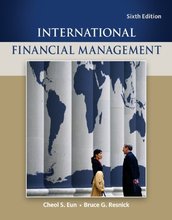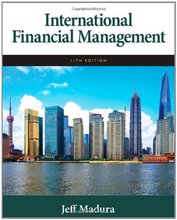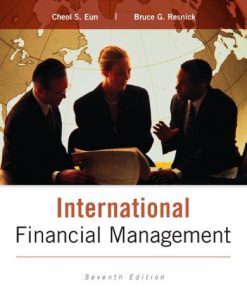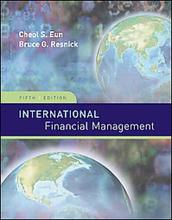International Financial Management Eun 7th Edition Test Bank
$35.00 Original price was: $35.00.$26.50Current price is: $26.50.
International Financial Management Eun 7th Edition Test Bank
Instant download International Financial Management Eun 7th Edition Test Bank pdf docx epub after payment.
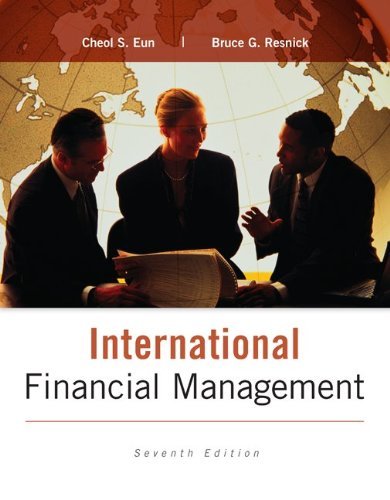
Chapter 01
Globalization and the Multinational Firm
Multiple Choice Questions
1. What major dimension sets apart international finance from domestic finance?
A. Foreign exchange and political risks
B. Market imperfections
C. Expanded opportunity set
D. All of the above
2. An example of a political risk is
A. expropriation of assets.
B. adverse change in tax rules.
C. the opposition party being elected.
D. both answers a and b are correct.
3. Production of goods and services has become globalized to a large extent as a result of
A. natural resources being depleted in one country after another.
B. skilled labor being highly mobile.
C. multinational corporations’ efforts to source inputs and locate production anywhere where costs are lower and profits higher.
D. common tastes worldwide for the same goods and services.
4. Recently, financial markets have become highly integrated. This development
A. allows investors to diversify their portfolios internationally.
B. allows minority investors to buy and sell stocks.
C. has increased the cost of capital for firms.
D. answers a and c are both correct.
5. Japan has experienced large trade surpluses. Japanese investors have responded to this by
A. liquidating their positions in stocks to buy dollar denominated bonds.
B. investing heavily in U.S. and other foreign financial markets.
C. lobbying the U.S. government to depreciate its currency.
D. lobbying the Japanese government to allow the yen to appreciate.
6. Suppose your firm invests $100,000 in a project in Italy. At the time the exchange rate is $1.25 = €1.00. One year later the exchange rate is the same, but the Italian government has expropriated your firm’s assets paying only €80,000 in compensation. This is an example of
A. exchange rate risk.
B. political risk.
C. market imperfections.
D. none of the above, since $100,000 = €80,000 × $1.25/€1.00
7. Suppose you start with $100 and buy stock for £50 when the exchange rate is £1 = $2. One year later, the stock rises to £60. You are happy with your 20 percent return on the stock, but when you sell the stock and exchange your £60 for dollars, you only get $45 since the pound has fallen to £1 = $0.75. This loss of value is an example of
A. exchange rate risk.
B. political risk.
C. market imperfections.
D. weakness in the dollar.
8. Suppose that Great Britain is a major export market for your firm, a U.S.-based MNC. If the British pound depreciates against the U.S. dollar,
A. your firm will be able to charge more in dollar terms while keeping pound prices stable.
B. your firm may be priced out of the U.K. market, to the extent that your dollar costs stay constant and your pound prices will rise.
C. to protect U.K. market share, your firm may have to cut the dollar price of your goods to keep the pound price the same.
D. both b and c are correct
9. Suppose Mexico is a major export market for your U.S.-based company and the Mexican peso appreciates drastically against the U.S. dollar. This means
A. your company’s products can be priced out of the Mexican market, as the peso price of American imports will rise following the peso’s fall.
B. your firm will be able to charge more in dollar terms while keeping peso prices stable.
C. your domestic competitors will enjoy a period of facing lessened price competition from Mexican imports.
D. both b and c are correct
10. Suppose Mexico is a major export market for your U.S.-based company and the Mexican peso depreciates drastically against the U.S. dollar, as it did in December 1994. This means that
A. your company’s products can be priced out of the Mexican market, as the peso price of American imports will rise following the peso’s fall.
B. your firm will be able to charge more in dollar terms while keeping peso prices stable.
C. your domestic competitors will enjoy a period of facing little price competition from Mexican imports.
D. both b and c are correct
11. Suppose that you are a U.S. producer of a commodity good competing with foreign producers. Your inputs of production are priced in dollars and you sell your output in dollars. If the U.S. currency depreciates against the currencies of our trading partners,
A. your competitive position is likely improved.
B. your competitive position is likely worsened.
C. your competitive position is unchanged.
You may also like…
Solution Manual





